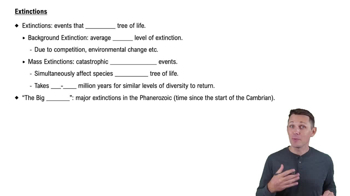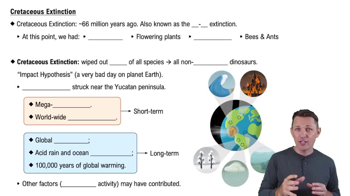Table of contents
- 1. Introduction to Biology2h 42m
- 2. Chemistry3h 40m
- 3. Water1h 26m
- 4. Biomolecules2h 23m
- 5. Cell Components2h 26m
- 6. The Membrane2h 31m
- 7. Energy and Metabolism2h 0m
- 8. Respiration2h 40m
- 9. Photosynthesis2h 49m
- 10. Cell Signaling59m
- 11. Cell Division2h 47m
- 12. Meiosis2h 0m
- 13. Mendelian Genetics4h 44m
- Introduction to Mendel's Experiments7m
- Genotype vs. Phenotype17m
- Punnett Squares13m
- Mendel's Experiments26m
- Mendel's Laws18m
- Monohybrid Crosses19m
- Test Crosses14m
- Dihybrid Crosses20m
- Punnett Square Probability26m
- Incomplete Dominance vs. Codominance20m
- Epistasis7m
- Non-Mendelian Genetics12m
- Pedigrees6m
- Autosomal Inheritance21m
- Sex-Linked Inheritance43m
- X-Inactivation9m
- 14. DNA Synthesis2h 27m
- 15. Gene Expression3h 20m
- 16. Regulation of Expression3h 31m
- Introduction to Regulation of Gene Expression13m
- Prokaryotic Gene Regulation via Operons27m
- The Lac Operon21m
- Glucose's Impact on Lac Operon25m
- The Trp Operon20m
- Review of the Lac Operon & Trp Operon11m
- Introduction to Eukaryotic Gene Regulation9m
- Eukaryotic Chromatin Modifications16m
- Eukaryotic Transcriptional Control22m
- Eukaryotic Post-Transcriptional Regulation28m
- Eukaryotic Post-Translational Regulation13m
- 17. Viruses37m
- 18. Biotechnology2h 58m
- 19. Genomics17m
- 20. Development1h 5m
- 21. Evolution3h 1m
- 22. Evolution of Populations3h 52m
- 23. Speciation1h 37m
- 24. History of Life on Earth2h 6m
- 25. Phylogeny2h 31m
- 26. Prokaryotes4h 59m
- 27. Protists1h 12m
- 28. Plants1h 22m
- 29. Fungi36m
- 30. Overview of Animals34m
- 31. Invertebrates1h 2m
- 32. Vertebrates50m
- 33. Plant Anatomy1h 3m
- 34. Vascular Plant Transport1h 2m
- 35. Soil37m
- 36. Plant Reproduction47m
- 37. Plant Sensation and Response1h 9m
- 38. Animal Form and Function1h 19m
- 39. Digestive System1h 10m
- 40. Circulatory System1h 57m
- 41. Immune System1h 12m
- 42. Osmoregulation and Excretion50m
- 43. Endocrine System1h 4m
- 44. Animal Reproduction1h 2m
- 45. Nervous System1h 55m
- 46. Sensory Systems46m
- 47. Muscle Systems23m
- 48. Ecology3h 11m
- Introduction to Ecology20m
- Biogeography14m
- Earth's Climate Patterns50m
- Introduction to Terrestrial Biomes10m
- Terrestrial Biomes: Near Equator13m
- Terrestrial Biomes: Temperate Regions10m
- Terrestrial Biomes: Northern Regions15m
- Introduction to Aquatic Biomes27m
- Freshwater Aquatic Biomes14m
- Marine Aquatic Biomes13m
- 49. Animal Behavior28m
- 50. Population Ecology3h 41m
- Introduction to Population Ecology28m
- Population Sampling Methods23m
- Life History12m
- Population Demography17m
- Factors Limiting Population Growth14m
- Introduction to Population Growth Models22m
- Linear Population Growth6m
- Exponential Population Growth29m
- Logistic Population Growth32m
- r/K Selection10m
- The Human Population22m
- 51. Community Ecology2h 46m
- Introduction to Community Ecology2m
- Introduction to Community Interactions9m
- Community Interactions: Competition (-/-)38m
- Community Interactions: Exploitation (+/-)23m
- Community Interactions: Mutualism (+/+) & Commensalism (+/0)9m
- Community Structure35m
- Community Dynamics26m
- Geographic Impact on Communities21m
- 52. Ecosystems2h 36m
- 53. Conservation Biology24m
28. Plants
Land Plants
Problem 7`
Textbook Question
The history of life has been punctuated by several mass extinctions. For example, the impact of a meteorite may have wiped out most of the dinosaurs and many forms of marine life at the end of the Cretaceous period. Fossils indicate that plants were less severely affected by this mass extinction. What adaptations may have enabled plants to withstand this disaster better than animals?
 Verified step by step guidance
Verified step by step guidance1
Consider the differences in survival strategies between plants and animals. Plants are generally more adaptable to changes in their environment due to their ability to photosynthesize, which allows them to produce their own food from sunlight, water, and carbon dioxide.
Examine the structural adaptations of plants. Many plants have developed tough, protective outer layers such as bark or waxy coatings that can help them withstand harsh environmental conditions, including changes in climate or atmospheric composition.
Evaluate the reproductive strategies of plants. Unlike many animals, plants can reproduce both sexually and asexually. Asexual reproduction, such as through spores or vegetative propagation, allows plants to quickly repopulate an area even if individual plants are wiped out.
Analyze the role of seed dispersal and dormancy. Seeds can remain dormant for extended periods, allowing them to survive unfavorable conditions until the environment becomes suitable for growth. This ability to 'wait out' adverse conditions could have been crucial during a mass extinction event.
Consider the ecological roles of plants. Plants are primary producers in ecosystems, forming the base of the food chain. Their ability to adapt and survive would have been essential for the recovery of ecosystems after a mass extinction, providing food and habitat for surviving animal species.
 Verified video answer for a similar problem:
Verified video answer for a similar problem:This video solution was recommended by our tutors as helpful for the problem above
Video duration:
2mPlay a video:
Was this helpful?
Key Concepts
Here are the essential concepts you must grasp in order to answer the question correctly.
Mass Extinction Events
Mass extinction events are periods in Earth's history when a significant, widespread, and rapid decrease in the biodiversity occurs. These events are often triggered by catastrophic phenomena such as meteorite impacts, volcanic eruptions, or climate changes. Understanding these events helps explain the evolutionary pressures that shape the survival and adaptation of species.
Recommended video:

Extinctions
Plant Adaptations
Plant adaptations refer to the evolutionary changes that enable plants to survive and thrive in various environmental conditions. These adaptations can include structural features like thick bark or deep roots, physiological mechanisms like drought resistance, and reproductive strategies such as seed dispersal. Such traits may have contributed to plants' resilience during mass extinction events.
Recommended video:

Adaptive Radiation
Cretaceous-Paleogene Extinction
The Cretaceous-Paleogene extinction, occurring about 66 million years ago, is one of the most well-known mass extinction events, marked by the disappearance of the dinosaurs and many marine species. It is believed to have been caused by a meteorite impact, leading to drastic environmental changes. Studying this event provides insights into how different life forms, including plants, adapted to survive the aftermath.
Recommended video:

Cretaceous Extinction
Related Videos
Related Practice










